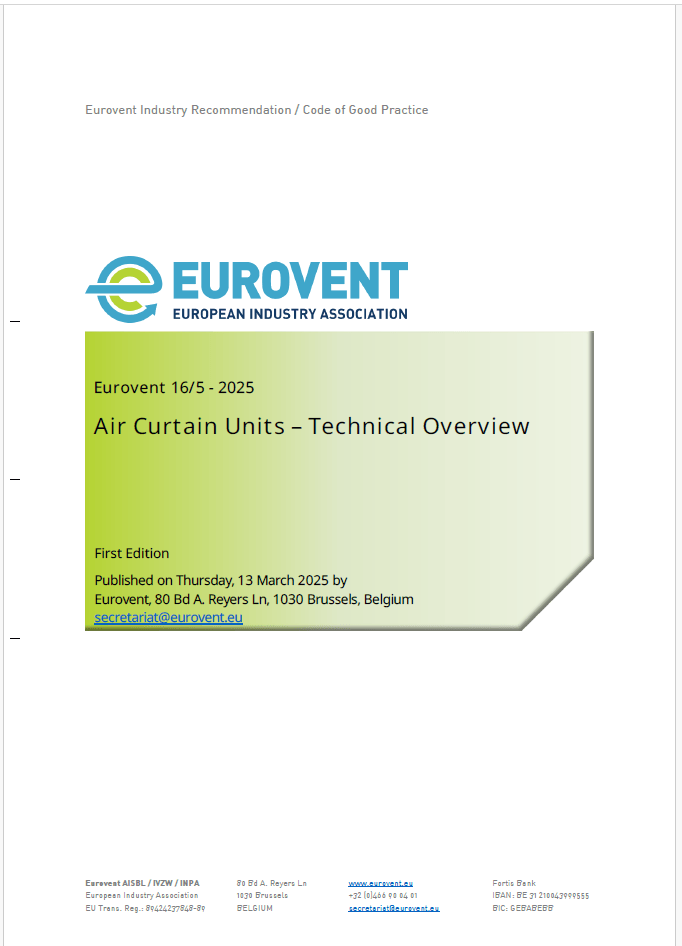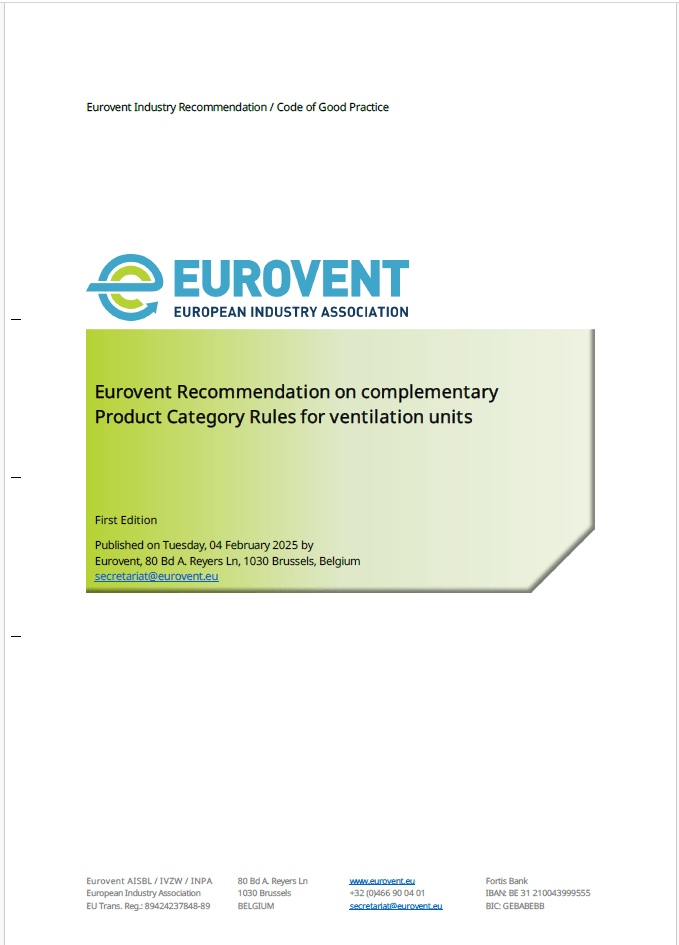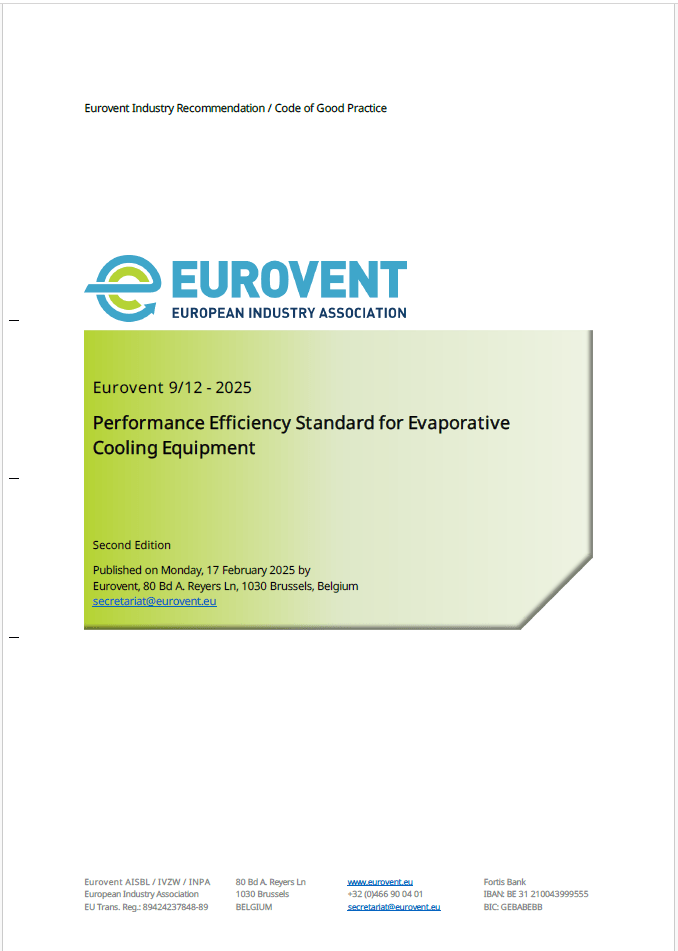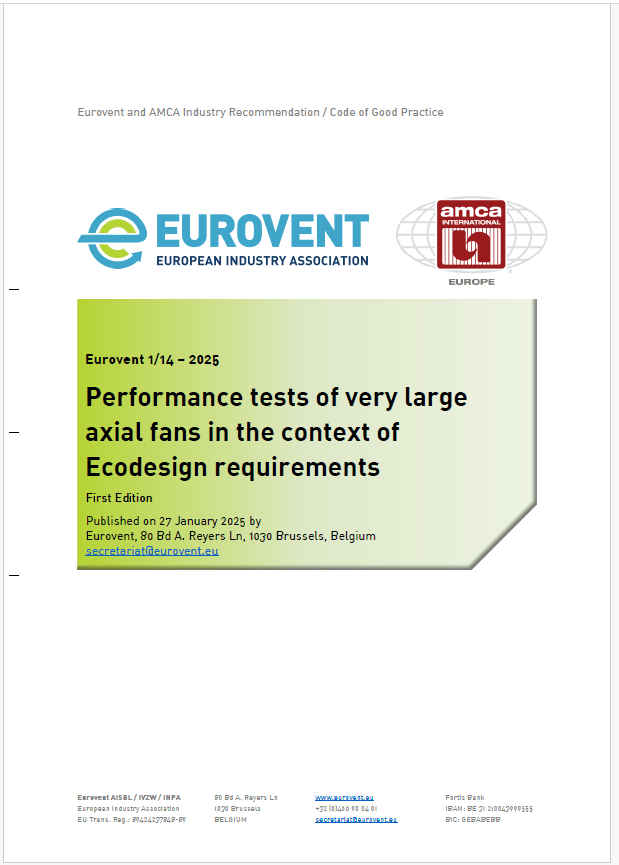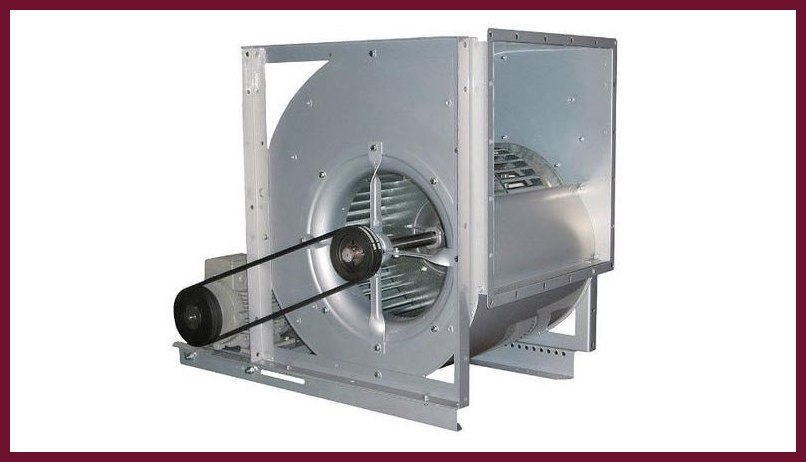Experts speak to Eurovent Middle East and provide a broad overview on the differences between belt-driven and direct-driven fans, factors that propel demand in the region, and the need for greater awareness and education in order to move the needle towards adoption of more efficient technologies in the market.
Fans are omnipresent in HVACR systems. They are in fan coil units, in ducted ventilation systems, appear as exhaust fans in kitchens and bathrooms, find their way in refrigerators and critical machineries, and are one of the key components in Air Handling Units (AHUs). A typical hotel in Dubai can easily harbour more than 2.000 fans within its infrastructure. Thus, it is no surprise that fans have a significant impact on the energy consumption of a building and, to a greater extent, of a country.

 The European Union has accounted for the impact of fans on the continent’s energy consumption through the introduction of what is commonly known as the EU Fan regulation, implemented as part of its Ecodesign policy in 2011. Markus Lattner, Managing Director of Eurovent Middle East recalls when this regulation came to pass: “Initially, the EU Fan Regulation met with some resistance and created confusion within the industry. However, it proved to be a motor for innovation and investment. Following its implementation, it is estimated that in the period between 2011 and 2018, more than 46,000 GWh of energy savings was achieved.”
The European Union has accounted for the impact of fans on the continent’s energy consumption through the introduction of what is commonly known as the EU Fan regulation, implemented as part of its Ecodesign policy in 2011. Markus Lattner, Managing Director of Eurovent Middle East recalls when this regulation came to pass: “Initially, the EU Fan Regulation met with some resistance and created confusion within the industry. However, it proved to be a motor for innovation and investment. Following its implementation, it is estimated that in the period between 2011 and 2018, more than 46,000 GWh of energy savings was achieved.”
Unfortunately, the Middle East presents a completely different scenario. Despite the region’s high ambient conditions already necessitating greater energy usage, older or incorrectly specified technology is the norm, rather than the exception. Being largely eradicated from the European market, belt-driven fans are still heavily used and widely popular among investors and planners in the region.

 Speaking on trends in the Middle East, Lubna Shaikh, Senior Manager, Business Development, Trosten, points out that both belt-driven and direct-driven fans are used in AHUs in the region, and that it is important to have a clear understanding of factors that influence demand as every system presents advantages and disadvantages for each stakeholder. “In the current market, belt-driven fans are typically used for commercial and residential projects, as it is a more popular and cost-effective solution,” she says. Shaikh adds that belt-driven fans have also been used over many decades because it is considered a proven system for AHUs, and that applications involving larger volumes of air flow rates are easily addressed with a single fan belt-driven system.
Speaking on trends in the Middle East, Lubna Shaikh, Senior Manager, Business Development, Trosten, points out that both belt-driven and direct-driven fans are used in AHUs in the region, and that it is important to have a clear understanding of factors that influence demand as every system presents advantages and disadvantages for each stakeholder. “In the current market, belt-driven fans are typically used for commercial and residential projects, as it is a more popular and cost-effective solution,” she says. Shaikh adds that belt-driven fans have also been used over many decades because it is considered a proven system for AHUs, and that applications involving larger volumes of air flow rates are easily addressed with a single fan belt-driven system.

 Making a case for direct-driven fans, Morten Schmelzer, Technical Marketing Director, Systemair Group says, “Simple physics proves that belt-driven fans are inefficient in terms of energy consumption compared with modern solutions such as EC plug fans, i.e. a direct-driven fan motor combination. It is also proven that belt drives can pollute the supply air stream and harm products like AHUs due to issues such as rubber residue.”
Making a case for direct-driven fans, Morten Schmelzer, Technical Marketing Director, Systemair Group says, “Simple physics proves that belt-driven fans are inefficient in terms of energy consumption compared with modern solutions such as EC plug fans, i.e. a direct-driven fan motor combination. It is also proven that belt drives can pollute the supply air stream and harm products like AHUs due to issues such as rubber residue.”

 Frank Taaning Grundholm, Vice President, Global HVACR Sales, ABB Motion, adds that the continued use of belt-driven fans leads to additional energy losses in the transmission between the motor and the fans. “Moreover, a lot of these belt drives are not well-maintained,” he says. “This causes a slip or complete failure of the belt drive and, in many cases, the function of the belt drive is not monitored. Though variable speed drives can be setup to monitor the belt drive, it will always be less efficient than direct-driven fans.”
Frank Taaning Grundholm, Vice President, Global HVACR Sales, ABB Motion, adds that the continued use of belt-driven fans leads to additional energy losses in the transmission between the motor and the fans. “Moreover, a lot of these belt drives are not well-maintained,” he says. “This causes a slip or complete failure of the belt drive and, in many cases, the function of the belt drive is not monitored. Though variable speed drives can be setup to monitor the belt drive, it will always be less efficient than direct-driven fans.”

 For Koen van Nistelrooij, Managing Director, ebm-papst, direct-driven, speed-controlled fans are the most suitable option for AHUs. He encourages utilising fan manufacturers’ experience and knowledge about positioning the fan in the unit to ensure it is working optimally, adding that direct-driven fans have the benefit of being easier to install, having less maintenance costs, and offering multiple available options.
For Koen van Nistelrooij, Managing Director, ebm-papst, direct-driven, speed-controlled fans are the most suitable option for AHUs. He encourages utilising fan manufacturers’ experience and knowledge about positioning the fan in the unit to ensure it is working optimally, adding that direct-driven fans have the benefit of being easier to install, having less maintenance costs, and offering multiple available options.
Shaikh highlights that direct-driven fans are also a preferred option for LEED-certified projects, which has seen growing interest in the region. She says that EC direct-driven fans placed in an array also serve as a good solution to address redundancies in operation theatres, data centres, and other critical applications. “In addition, direct-driven fans are highly suitable and recommended for their advantages for hygienic applications, such as convenience and ease in cleaning,” she adds.
Grundholm mentions more opportunities can be unlocked highlighting how using variable speed drives with direct-drive fans can better match the airflow requirements of the building at the lowest possible energy usage. “In addition to eliminating the belt drive, the variable speed drives will also operate the fans more efficiently and the dampers will only be used to provide air seal, when no flow is required, such as, when it comes to managing a fire efficiently,” he says.
Generally, van Nistelrooij says choosing state-of-the-art technologies will help increase the overall efficiency of the complete installation. “Direct-driven fans will save an extra filter after the fan to get rid of rubber particles, this reduces the internal pressure losses. It would also be helpful to use speed controllers to always supply the amount of air needed, half speed means half the amount of air but only about 15% input power compared to full speed.”
The need to drive a positive shift
However, there are a number of factors particular to the Middle East that prove to be a bottleneck for greater adoption of direct-driven fans. Schmelzer attributes this to the lack of minimum energy performance standards in the region. “In the event that there are regulations, the requirements still tend to be at a low level, meaning that belt-driven solutions can still be placed on the market without issues,” he says.
Lack of awareness also contributes to proliferation of these technologies, says Schmelzer. “In some cases, customers used to belt drives are simply not aware of its negative impact and that today`s solutions are much more beneficial,” he adds. “In the EU, through the Ecodesign Regulations, belt-driven fans are barely ever utilised anymore. The market has completely transformed and innovated due to applied boundary conditions.”
Van Nistelrooij says the prolonged use of outdated technologies is a result of habit. “For consultants, it is always easier to work and operate within a comfort zone to ensure they have expertise on all components and details on a particular technology, rather than to invest time in “new” technologies and find out how these exactly work. If consultants had more knowledge about and confidence in the use of direct-driven fans, they would always go for these solutions rather than belt-driven solutions.”
Schmelzer points out that specifications that are not adapted over time only adds to the problem. “The same specification requirements are copied year after year, without adapting them to the state-of-the-art in technological innovation and standards,” he says. Grundholm seconds this, adding, “In many cases specifications are not specific enough, which means that the contractors have the option of choosing the lowest cost solution and still comply with specification.”
The cost of ‘cheap’
However, the most common roadblock to greater adoption relates to price pressure. “Unfortunately, the least efficient and outdated solution often tends to be the cheapest,” says Schmelzer. “The initial price counts, but not the price over a longer usage time. Even if the consultant highlights this to the investor, they often don`t get through. Accordingly, some customers opt for belt-driven solution, looking at costs over energy efficiency and sustainability.”
In agreement, van Nistelrooij points out that capital cost (capex) often drives project decisions. “Belt-driven blowers are cheaper than direct-driven speed-controlled fans,” he says. “But when we look at the operation costs over time, we get a completely different picture as the operating costs are in many cases more than 95% of the overall Life Cycle Costs (LCC).” Essentially, van Nistelrooij stresses, the dilemma lies in the fact that the investor is taking care of the capex, but the user of the building has to take care about the opex. “Very often the investor and the user are not the same person, that makes it really tricky for the consultant,” he says.
Schmelzer provides an example to underline this phenomenon. “For the construction of a major restaurant at the Palm Island in Dubai, AHUs were required,” he shares. “The cheapest solution with belt-driven fans was selected. While the initial price might have been cheaper, the energy consumption over 4-6 years was much higher and the rate of refurbishment increased.” Schmelzer adds that compared to other regions, the refurbishment rate of buildings in the Middle East is generally higher. As a result, he says, in the long run, cheaper solutions, such as belt drives, always cost more.
Grundholm says that to date the only argument for the belt-driven solution is that they are cheaper. “Direct-driven fans are more compact and have higher unit efficiency,” he says. “Sometimes it requires a change in AHU design to leverage modern fan designs, which is of course a cost for the manufacturer, but technically any air handling task can be managed with direct-drive solutions, so there is no argument against updating the specifications to block the belt-driven solutions.”
Grundholm further adds that any loss that can be removed without impacting operation negatively should be removed, otherwise “we will never have the best possible utilisation of our resources”. “In addition to the energy efficiency and potential operation failures, the indoor air quality is also affected,” he says. “This is because there will be dust from the wear of the belts, which best case just adds load to the filter, but worst case passes the filter and then people in the buildings are also breathing the dust in our buildings. Poor indoor air quality is not sustainable, as it deteriorates the quality of life for the people using the buildings and potentially increase our costs for providing required healthcare.”
A push to raise the bar
The industry has a larger role to play in driving better solutions in the market. For Grundholm, it is not only a question of the available technical solutions to achieve the highest energy efficiency. “In my view, we need to support the consultants to strengthen the specifications, so belt-driven solutions are eliminated without causing unfair trade barriers,” he says. “It is essential that specifications support competition in the market and provide room for development of new innovative solutions, which positively support a sustainable development.” He adds that specifications have to state needs and requirements but should focus as little as possible on specific technologies as new technologies enter the market all the time.
Lattner believes that international climate agreements will also soon have an impact. “Following the Paris Agreement, there is mounting pressure on every government to accelerate the reduction of carbon emissions,” he says. “This results in a growing number of technical regulations incorporating minimum energy performance standards. Within the region, countries like Saudi Arabia are demanding a minimum motor efficiency corresponding to IE3 classification. We expect that within the next five years, there will be a more defined approach towards fans and fan motor technologies by regulatory bodies.”
However, Lattner also underlines the responsibility of the building industry. “If we have more efficient technology available, then we must alert market players and motivate them to switch as soon as possible, rather than waiting for governments to act,” he says. “The leaders in Middle East have provided clear visions for a sustainable future. If we applaud them for it, we also have to act accordingly.”
For Schmelzer, what is needed is the strong engagement of associations, such as Eurovent Middle East and AMCA, to work towards higher standards, educate the market, and objectively outline the benefits of thinking in the long-term instead of only about the initial sales price. “The recommendation to phase out belt-driven fans soon to be published by Eurovent Middle East can only be the beginning of a multitude of actions to take the HVACR sector in the GCC region to the next level for the mutual benefit of society, economy and the environment,” he says.
Sidebar:
When does it make sense to have a belt-driven fan?
Lubna Shaikh, Senior Manager, Business Development, Trosten believes that it is important to provide context for the use of belt-driven technologies, adding that smaller air flow rates selected for higher static pressures are required to operate at very high speeds, and such speeds are generally addressed by the selection of drives in belt driven system. “For direct-driven, the fan speed shouldn’t exceed the motor speed,” she says. “For example, if a 2-pole motor is selected, the motor speed is 2900 rpm approximately and in such a case, the fan selection of a direct-driven system shouldn’t exceed a speed of 2900 rpm. In case of very high air flow rates, due to single width construction followed for plenum / plug fans, we need to select multiple fans. With multiple fans, it is important to consider non-return dampers to avoid any recycling of air through the failed fan or fan resulted in breakdown.”
Morten Schmelzer, Technical Marketing Director, Systemair Group also says there are certain cases where belt-driven fans are suitable, such as for scroll housing. “If you have a high external static pressure, or high total static pressure, a plug fan can have trouble coping with it,” he explains. “This becomes valid as of roughly 1200Pa total static pressure, in which case the scroll housing is required to transfer dynamic pressure into static pressure.”
Shaik adds that for belt-driven fans, drives need to be selected at least at 150% over the power to be transmitted as drives selected to the exact power of transmission may lead to heating up of drives and sometimes, breakage in belts. “Typically, the belts expand a bit during the first few weeks of the operation and require tightening of drives to avoid belt sagging,” she says. “Laser tools allow accurate and efficient alignment of drives. Periodic maintenance is required to lube drive shaft bearings, align the sheaves, and tighten the belt. Semi-skilled technician can handle standard starter panel which are normally used for belt driven systems. In case of VFD panels, skilled technicians are required.”
Further drawing a comparison, Shaikh says that belt-driven fans can be connected to conventional starters and VFD is not mandatory because any air flow rate corrections are generally carried out by changing the drives applying the fan law. “Variable Frequency Drive (VFD) is a must in case of direct-driven fans,” she says.









